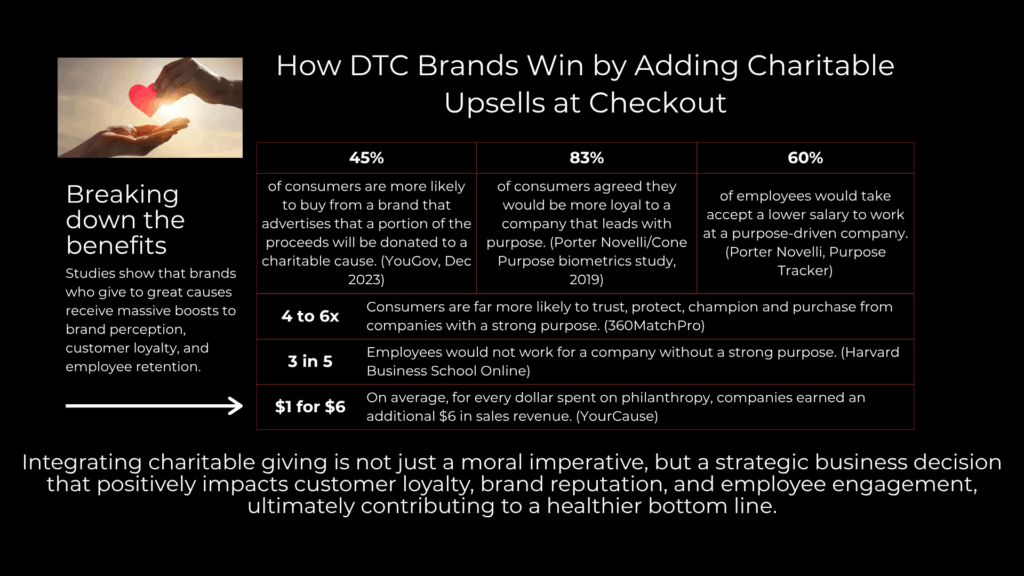As anyone in e-commerce will tell you, competition is both fierce and plentiful. Direct-to-Consumer (DTC) brands are constantly seeking innovative ways to boost conversions, build loyalty, and differentiate themselves. While product quality and marketing prowess remain crucial, there’s a powerful, often overlooked strategy that delivers significant benefits: integrating a donation to a non-profit upsell at checkout.
This isn’t just about corporate social responsibility (though that’s a huge plus!). For DTC brands, methods like round-up campaigns and small fixed-sum donations at the point of purchase offer a compelling trifecta of increased revenue, enhanced brand perception, and deeper customer engagement.
Here’s how adding a nonprofit upsell at checkout can be a game-changer for your DTC brand:
1. Boosting Average Order Value (AOV) and Revenue:
It might seem counterintuitive to ask for more money, but studies consistently show that customers are willing to contribute to causes they care about.
- The “Feel-Good” Factor: A small donation, often just a few cents or dollars, provides an emotional uplift for the customer, making them feel like their purchase has a greater purpose. This positive association can make them more likely to complete the transaction and even add more to their cart.
- Passive Philanthropy: Round-up campaigns, where customers simply round their purchase up to the nearest dollar, are incredibly effective because they require minimal effort and the perceived cost is negligible. These small, frequent donations accumulate rapidly.
- Increased Conversion Rates: In some cases, the option to donate can actually increase conversion rates by adding an element of positive reinforcement to the purchasing decision.
2. Enhancing Brand Image and Reputation:
Consumers, especially younger demographics, are increasingly prioritizing brands that align with their values.
- Authentic Social Responsibility: Partnering with a reputable non-profit demonstrates a genuine commitment to social good, moving beyond mere marketing rhetoric. This resonates deeply with conscious consumers.
- Building Trust and Transparency: Clearly communicating which non-profit you’re supporting and the impact of the donations builds trust and transparency with your customer base.
- Standing Out from the Crowd: In a crowded DTC market, a strong commitment to social impact can be a powerful differentiator, attracting customers who actively seek out ethical brands.
3. Deepening Customer Engagement and Loyalty:
A shared sense of purpose bolsters a stronger connection between your brand and your customers.
- Emotional Connection: When customers contribute to a cause through your brand, they develop a more emotional connection to your business. This goes beyond a transactional relationship.
- Repeat Purchases: Customers who feel good about their previous purchase and its impact are more likely to return for future purchases. It creates a positive feedback loop.
- Word-of-Mouth Marketing: Customers are more likely to share their positive experiences with brands that demonstrate social responsibility, leading to valuable organic marketing.
4. Simplicity of Implementation:
Thanks to readily available apps and integrations, implementing a donation upsell at checkout is surprisingly straightforward. Platforms like Shopify and other e-commerce solutions offer seamless ways to integrate these functionalities, often with minimal development effort. You can choose to:
- Round-Up to the Nearest Dollar: The most popular and often most effective method.
- Fixed-Sum Donation: Offer customers the option to add a set amount (e.g., $1, $5) to their order.
- Percentage of Purchase: Donate a percentage of the purchase price, with the customer simply opting in.
Key Considerations for Success:
- Choose the Right Partner: Select a non-profit whose mission aligns with your brand values and resonates with your target audience.
- Transparency is Key: Clearly communicate how much is being donated, to whom, and the impact of those donations.
- Promote Your Efforts: Don’t be shy about sharing your philanthropic initiatives on social media, in email campaigns, and on your website.
In an era where consumers vote with their wallets, DTC brands have a unique opportunity to blend profit with purpose. By strategically integrating a nonprofit upsell at checkout, you’re not just making a sale; you’re building a community, enhancing your brand, and contributing to a better world, one round-up at a time.

